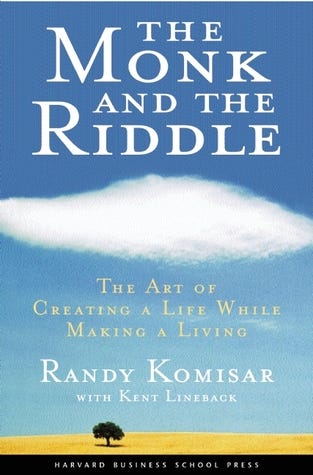The Monk and the Riddle by Randy Komisar
Based on a suggestion from Andrew Chen, I spent Saturday afternoon reading The Monk and the Riddle by Randy Komisar, which put me in a reflective mood on my own goals and vision for success here in Silicon Valley.
Randy Komisar put together a short narrative that challenges the traditional assumption of the deferred life plan, romanticizes the notion of business as a creative pursuit, and even finds room to go into a discourse on self-knowledge of one's own motivations. Beyond this, Randy litters throughout the book a great set of lessons from his own career as a successful entrepreneurial executive.
I thought I'd take a moment to share some of the highlights through a set of my favorite quotes from the book.
The Deferred Life Plan
The Deferred Life Plan. For the promise of full coverage under the plan, you must divide your life into two distinct parts:
Step one: Do what you have to do.
Then, eventually-
Step two: Do what you want to do.
The Deferred Life Plan certainly dominates Silicon Valley. Most people think getting rich fast provides the quickest way to get past the first step - and where can you get rich faster than Silicon Valley? The problem is that, despite the undisguised affluence, the verdant hills, and media-generated mythos, the vast majority of people in Silicon Valley will not get rich. Most business ideas do not find funding. Even the majority of those that are funded - that is, vetted by very smart people who think enough of the ideas to invest in them - ultimately fail. And the lucky winners may get to step two only to find themselves aimless, directionless.
Tim Ferriss echoes this same sentiment in The 4-Hour Work Week about how too many of us optimize for our deferred lives that may never materialize and both authors encourage finding ways to stop deferring and doing what you are most passionate about today.
Randy suggests that some of us may even postpone our ultimate life dreams indefinitely out of fear of risking what matters to us most only to find it ultimately uninteresting, unsatisfying, or unachievable. He encourages us to embrace that risk head on and right now; otherwise we face an even graver risk of never enjoying the rewards of pursuing our dreams.
Business as a Creative Institution
It comes down to my realization over the years that business isn't primarily a financial institution. It's a creative institution. Like painting and sculpting, business can be a venue for personal expression and artistry, at its heart more like a canvas than a spreadsheet.
This perspective on business rings true to my own view. I initially fell in love with coding as a creative hobby. I saw beauty in elegant solutions to technical problems. As I matured, business became the next logical pursuit in taking my solutions to problems and finding creative ways to commercialize and create value for all stakeholders.
Self-knowledge of Your Passion
Randy goes on to define where we traditionally source our notions of success, distinguishes passion from drive, and suggests that self-knowledge is paramount in making that distinction for yourself.
Most of us have inherited notions of success from someone else or have arrived at these notions by facing a seemingly endless line of hurdles extending from grade school through college and into our careers. We constantly judge ourselves against criteria that others have set and rank ourselves against others in their game. Personal goals, on the other hand, leave us on our own, without this habit of useless measurement and comparison.
Passion and drive are not the same at all. Passion pulls you toward something you cannot resist. Drive pushes you toward something you feel compelled or obligated to do. If you know nothing about yourself, you can't tell the difference. Once you gain a modicum of self-knowledge, you can express your passion.
Entrepreneurial Lessons
Littered throughout the book is a set of best practices for aspiring entrepreneurs from Randy's own entrepreneurial adventures. My personal favorite was his metaphor for CEO archetypes as various kinds of hounds and how different types are needed at different phases in a startup's lifecycle.
The first CEO is "the Retriever". From the muck she must assemble the core team, the product or service, and the market direction - all around a coherent vision. She must also raise the money and secure crucial early customers and partners. She is prized for her tenacity and inventiveness. The second CEO is "the Bloodhound." He must sniff out a trail - find the market and prove the business. He needs to build an operating team and establish a market beachhead. He is prized for his keen sense of direction and company-building skills. The third CEO is "the Husky." She must lead the team, pulling an operating company that grows heavier by the day with people and public company responsibilities. She is prized for her constancy and scalability. None of these, to me, is top dog. All are equal in importance, just different in skills and temperaments.
While much more theoretical and philosophical than the books I normally find myself reading, it turned out nonetheless to be an inspiring and thought-provoking read.
Whenever you’re ready, here are 3 ways I can help:
AI Productivity: Learn how leading product managers use AI to become faster, smarter, and gain super powers beyond their traditional role.
Mastering Product Management: Accelerate your product career by learning rigorous frameworks for each PM deliverable, from crafting a strategy to prioritizing a roadmap.
Product Innovation Strategy: Building a new product? Learn how to leverage the Deliberate Startup methodology, a modern approach to finding product/market fit.


